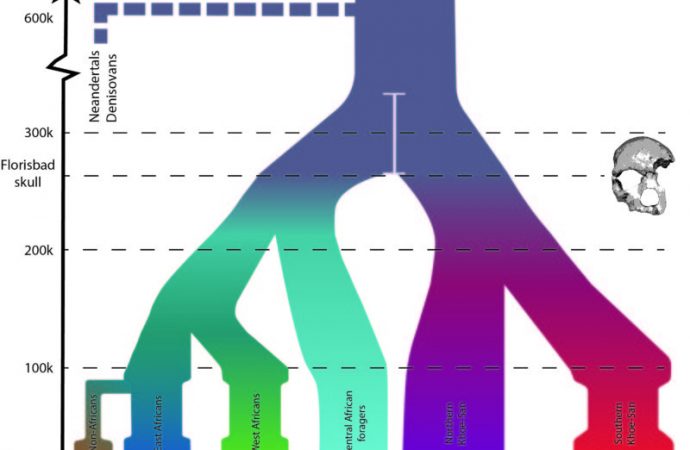There are a lot of caveats, but a Stone Age genome makes humanity look old.
When did humanity start? It’s proven to be a difficult question to answer. Anatomically modern humans have a distinct set of features that are easy to identify on a complete skeleton. But most old skeletons are partial, making identification a challenge. Plus, other skeletons were being left by pre-modern (or archaic) human relatives like Neanderthals who were present in Africa and Eurasia at the same time. While Neanderthals et al. have distinct features as well, we don’t always have a good idea how variable those features were in these populations.
So, when a recent paper argued that a semi-modern skull meant that humanity was older than we thought, some people dismissed it as an overhyped finding.
On Thursday, a new paper was released that makes the case that humanity’s older than we thought. The finding is based on a different type of evidence: a genome from a stone-age skeleton in southern Africa. There’s enough uncertainty in the work that this won’t settle the issue, but the paper reinforces earlier findings that the secret to understanding our past will be found in Africa.
All around Africa
Genetics and paleontology have both agreed that Africa gave rise to modern humans. The earliest clearly modern skeletons are found there, and genetics have suggested a group of African hunter-gatherers represent the earliest ethnic group on Earth. This group, the Khoe-San, have the most genetic diversity of any human population we’ve sampled. Since diversity accumulates with time, this implies they’re the oldest. Thus, it appears that the Khoe-San were the earliest group to branch off the modern human family tree and survive to the present.
Given some measures—like the frequency of mutations and the typical time for each generation of humans to reproduce—it’s possible to use that diversity to estimate the age of the Khoe-San split at between 100,000 and 150,000 years ago. Humanity as a whole, therefore, has to be at least that old. When first estimated, it was consistent with the appearance of modern human skeletal features in the paleontological record. So nearly everyone was happy.
But more recently, there have been finds like the skeleton mentioned above. And others have questioned whether the Khoe-San had such a neat genetic split from the rest of us. The region of southwest Africa they inhabit was swept through by the immense Bantu expansion, which spread agriculture and Iron Age technology throughout sub-Saharan Africa. If some Bantu DNA ended up spreading into the Khoe-San population, then our estimates would be off.
That’s precisely the issue that the new paper addresses. It does so by obtaining DNA from skeletons from of Stone Age Africans in the same region now occupied by the Khoe-San. These predate the Bantu arrival in the region and thus should have genomes that represent the ancestral Khoe-San population.
(The team also sequenced DNA from four Iron Age African skeletons at the same time and showed that the Bantu didn’t just bring technology; they carried genetic variants that provided some resistance to malaria and sleeping sickness. These were absent from the Stone Age skeletons.)
You look old
The authors only got one decent-quality genome out of the three Stone Age bones from which they obtained DNA. But that skeleton clearly groups with the Khoe-San genetically, indicating that the researchers’ expectation about its affinities were correct. A comparison with modern Khoe-San genomes, however, indicated that the modern ones have gotten contributions from an additional human lineage. All indications are that this DNA originated in East Africa and came from a population that had already been interbreeding with Eurasians.
This doesn’t mean that the Khoe-San aren’t the oldest lineage of humanity, but it does mean that they haven’t been genetically isolated from the rest of us. Which would throw off the date of their split from all of humanity’s other lineages.
So, how old are they? Comparing the Stone Age genome with other modern human genomes produces values of 285,000 to 365,000 years. The most extreme split is with the Mandinka, a population that currently occupies much of West Africa; the date of that appears to be 356,000 years.
Again, the Khoe-San are modern humans. And if they split off that long ago, then modern humans have existed for at least that long. And that’s substantially older than earlier genetic estimates.
But there are caveats. These estimates are very sensitive to the frequency at which new mutations arise in human lineages, as well as the typical human generation time. Both of those values have been in dispute in recent years. If the field arrives at a different consensus value, then these estimates will change. The authors also point out it’s possible that the split looks older because the ancestors of the Khoe-San had interbred with a population of archaic humans, much as the ancestor of non-Africans interbred with Neanderthals. That possibility’s going to be hard to exclude.
In the big picture of human evolution, a date of roughly 300,000 years ago would place the origin of modern humans almost half way between the present and when Neanderthals and Denisovans split off from our lineage. It also happens to be about the same time as the technology of the Middle Stone Age. It’s appealing to think that whatever breakthrough made us “modern” led to some sort of mental leap that enabled new technology. But, as the Bantu themselves demonstrated, the connection between a skeleton’s appearance and the technology its owner used can be extremely tenuous.
Source: Ars Technica

































Leave a Comment
You must be logged in to post a comment.